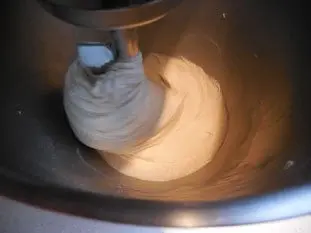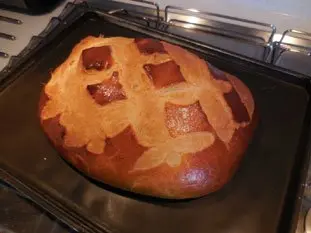Nantes Tourton
A recipe from cooking-ez.com September 12th 201894 K4.1
For 1 loaf, you will need:
- 1 400 g flour
- 2 15 g yeast
- 3 7 g salt
- 4 50 g fermented viennoiserie dough (optional)
- 5 310 ml milk
- 6 10 g vanilla sugar
- 7 50 g caster sugar
- 8 50 g butter
- 9 20 g beaten egg
- Total weight: 865 grams
Times:
| Preparation | Resting | Cooking | Start to finish |
|---|---|---|---|
| 25 min. | 6 hours 30 min. | 40 min. | 7 hours 35 min. |
Step by step recipe
| 1 | Put into a food-processor bowl: 400 g flour, 15 g yeast, 7 g salt, 50 g fermented viennoiserie dough and 310 ml milk (cold). |  |
| 2 | Knead on slow speed for 10 minutes. Note: For the best way to knead, see: A few tips for effective kneading at home. |  |
| 3 | Stop kneading to add 10 g vanilla sugar, 50 g caster sugar and 50 g butter. Knead again, still on slow speed, until the butter and sugar are completely mixed un. |  |
| 4 | Gather the dough (it is quite normal for this to be very sticky) into a ball and transfer to a clean bowl. Cover with a sheet of plastic. Leave to rest for 1 hour. |  |
| 5 | After resting, "break" the dough (similar to knocking back with a firmer dough) by stretching it upwards and letting it fall back sharply into the bowl. Do this 2 or 3 times. |  |
| 6 | Gather the dough into a ball again, cover with plastic film and leave in the fridge for at least 4 hours or overnight. |  |
| 7 | The dough will be easier to handle when it is really cold. Tip it onto a floured work surface and press it flat, then shape into a loaf: round, long (like this one), or whatever you prefer. Place the loaf on a baking sheet. |  |
| 8 | Glaze and leave to rest for 1 hour 30 minutes. |  |
| 9 | Preheat the oven to 370°F (190°C). Glaze the loaf again. |  |
| 10 | Slash the top in a criss-cross pattern (French bakers call this a "polka" cut). |  |
| 11 | Bake for about 40 minutes. |  |
| 12 | Leave to cool on a wire rack. |  |
Remarks
You can make a richer tourton by adding chocolate chips or raisins.View this recipe : https://cooking-ez.com/four/recipe-nantes-tourton.php
November 9th 2025.
